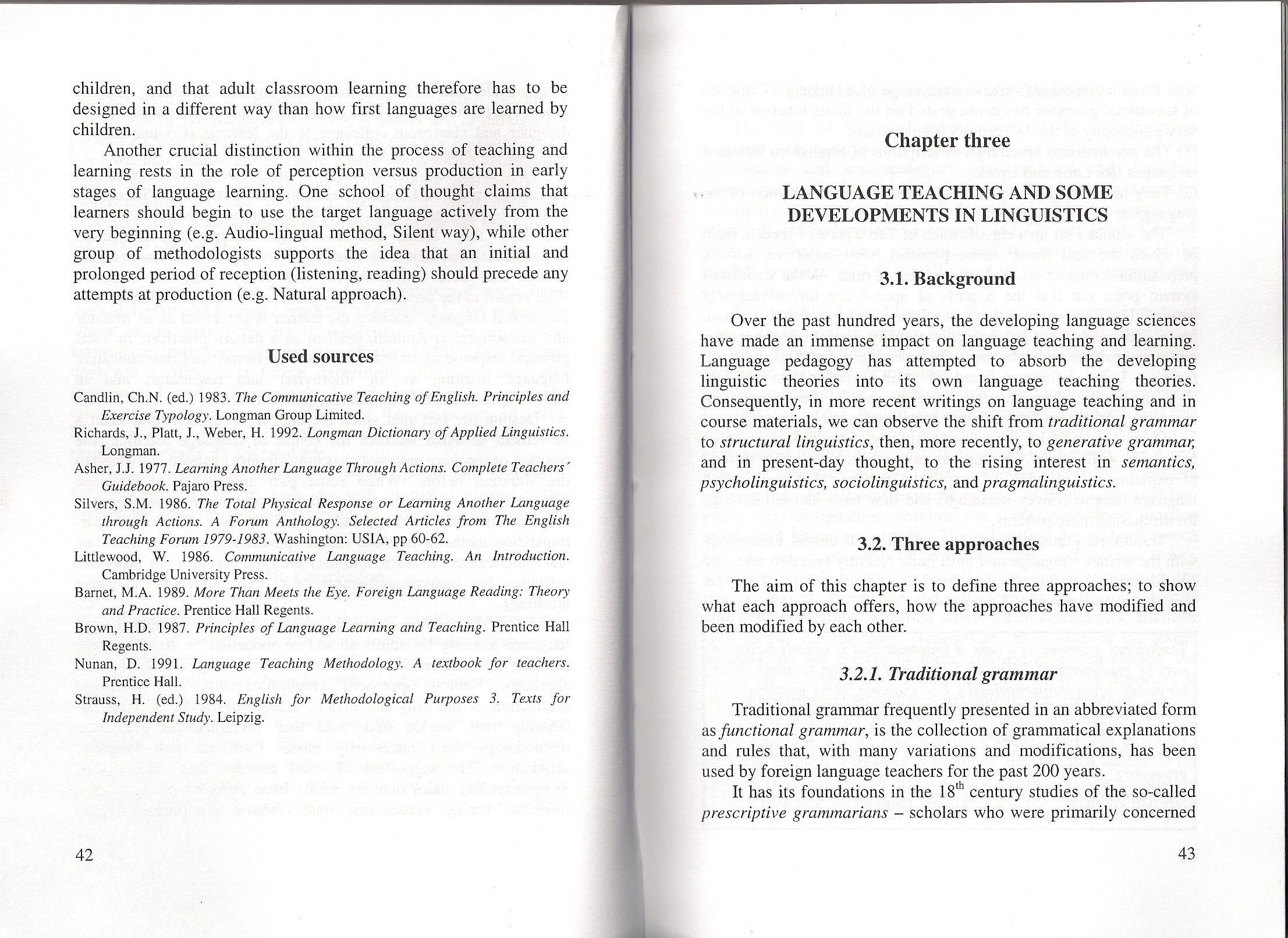skanowanie0021 (22)

children, and that adult classroom learning therefore has to be designed in a different way than how first languages are leamed by children.
Another crucial distinction within the process of teaching and learning rests in the role of perception versus production in early stages of language learning. One school of thought claims that leamers should begin to use the target language actively from the very beginning (e.g. Audio-lingual method, Silent way), while other group of methodologists supports the idea that an initial and prolonged period of reception (listening, reading) should precede any attempts at production (e.g. Natural approach).
Used sources
Candlin, Ch.N. (ed.) 1983. The Communicative Teaching of English. Principles and Exercise Typology. Longman Group Limited.
Richards, I., Platt, J., Weber, H. 1992. Longman Dictionary of Applied Linguistics. Longman.
Asher, J.J. 1977. Learning Another Language Through Actions. Complete Teachers' Guidebook. Pajaro Press.
Silvers, S.M. 1986. The Total Physical Response or Learning Another Language through Actions. A Forum Anthology. Selected Articles from The English Teaching Forum 1979-1983. Washington: USIA, pp 60-62.
Littlewood, W. 1986. Communicative Language Teaching. An Introduction. Cambridge University Press.
Bamet, M.A. 1989. Morę Than Meets the Eye. Foreign Language Reading: Theory and Practice. Prentice Hall Regents.
Brown, H.D. 1987. Principles of Language Learning and Teaching. Prentice Hall Regents.
Nunan, D. 1991. Language Teaching Methodology. A textbook for teachers. Prentice Hall.
Strauss, H. (ed.) 1984. English for Methodological Purposes 3. Texts for Independent Study. Leipzig.
Chapter three
LANGUAGE TEACHING AND SOME DEYELOPMENTS IN LINGUISTICS
3.1. Background
Over the past hundred years, the developing language Sciences have madę an immense impact on language teaching and learning. Language pedagogy has attempted to absorb the developing linguistic theories into its own language teaching theories. Conseąuently, in morę recent writings on language teaching and in course materials, we can observe the shift from traditional grammar to structural linguistics, then, morę recently, to generative grammar, and in present-day thought, to the rising interest in semantics, psycholinguistics, sociolinguistics, and pragmalinguistics.
3.2. Three approaches
The aim of this chapter is to define three approaches; to show what each approach offers, how the approaches have modified and been modified by each other.
3.2.1, Traditional grammar
Traditional grammar freąuently presented in an abbreviated form asfunctional grammar, is the collection of grammatical explanations and rules that, with many variations and modifications, has been used by foreign language teachers for the past 200 years.
It has its foundations in the 18* century studies of the so-called prescriptive grammarians - scholars who were primarily concemed
43
Wyszukiwarka
Podobne podstrony:
54United Nations — Treaty Series1972 category and the pertentage of eligible expenditures so to be f
1.2. Goal and Plan of the Work 3 It is assumed that the goal of this work can be reached in the foll
It has to be noted that membranę temperaturę and gases partial pressures change with celi current: w
full circ The arajit has to be madę to csallate for it to werk, and then the 09dllaticns have to be
skanowanie0107 (2) 12.4.5. Keys to teaching the writing skills A number of things
skanowanie0107 (2) 12.4.5. Keys to teaching the writing skills A number of things
skanowanie0107 (2) 12.4.5. Keys to teaching the writing skills A number of things
mb 29 MUSCLS BUILDING, 29 is to escrcise and dewlop tlić npjjor arm. The hand is to be placed in a s
Certificate ofCompletion This is to certify that Ewa Kozłowska successfully completed the Pr o duet
MR293R190?3 1 PREPARAT!ON AND PAISTING MKTHOD HO REPAIRS POSSIBLE Ali fittings to be painted in the
defiantinstr7 B* FDRWARD HULL A55EMBLY EBDTTDM3 * 2 - NOTĘ: Ali tabs labelled "26" need to
- Poetry was to be found in the Bibie: the resource of samts and angel1. -
it. He envies the figurę in the painting. saying that he would give his soul to be young forever as
47267 MR293R190?3 1 PREPARAT!ON AND PAISTING MKTHOD HO REPAIRS POSSIBLE Ali fittings to be painted i
więcej podobnych podstron